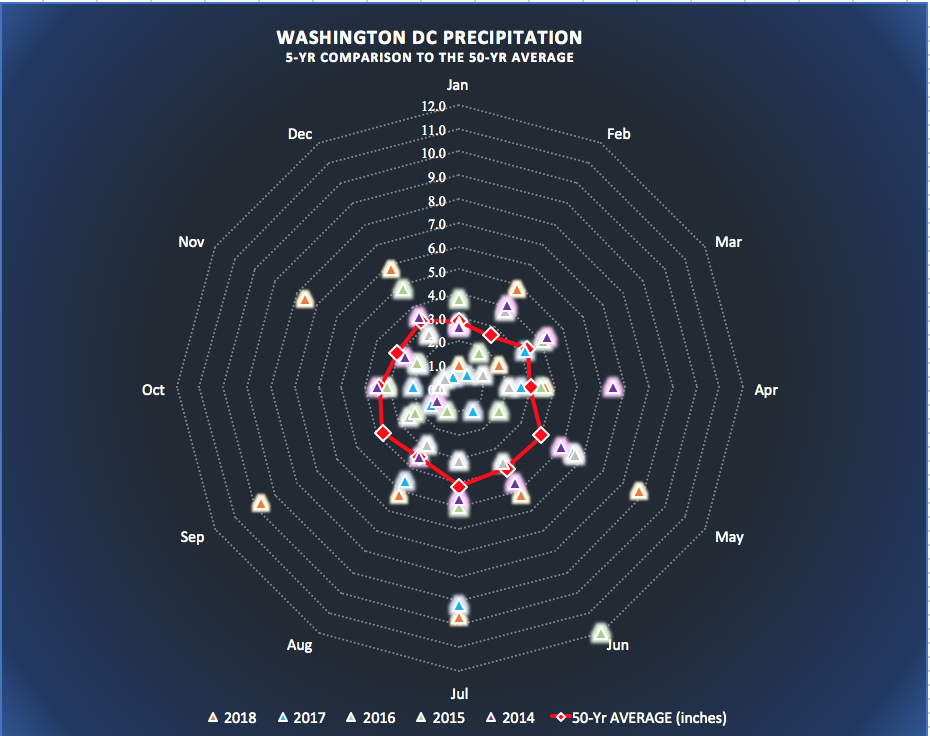2018: Record Rainfall and Construction Challenges
Climate change: it has been a much-debated topic for years. But putting aside the political and ideological discussions related to U. S climate policy, recent studies and data by independent sources have indicated a link between climate change and the notable increase of severe weather across the globe. As a result of this information, several jurisdictions on both local and State levels have begun implementing new regulations in an attempt to mitigate the risk associated with the increasing number of severe weather events.
Similarly, some private sector industries and firms have also adopted new standards to address the increased frequency of storms. Many insurance companies, for example, no longer accept outdated FEMA maps to establish 100-year flood elevation boundaries. Engineering professionals are now challenging previously accepted statistical storm intensity data that had historically been used for hydrology design, and urging the industry to reassess and update with more recent data.
The commercial construction industry has also been feeling the effects of severe weather. In 2018, weather-related setbacks were particularly significant locally, with detrimental impacts to projects’ schedules and budgets throughout the region. And yet to date, there have not been many new industry-wide standards implemented that attempt to directly deal with the risks associated with these storms. Each firm plans and adjusts to these severe weather patterns differently. At Northpoint, we recognize weather-related delays and cost impacts to a project as a normal part of business. Our team of engineers and construction management professionals utilize their industry experience, data and an ability to remain ever-flexible to create plans at the outset that include fluid schedules and contingency plans for when the unexpected inevitably arises. That said, 2018 really was one for the books. One local site subcontractor stated that during 2018, all of their projects experienced an average of six to eight weeks of delays – with most delays occurring during excavation and backfill operations. (Projects that are in the initial phases of sitework are especially vulnerable to weather delays as they are directly impacted by the inability to work with wet soils. Waterproofing and subsequent mold damage has also been attributed to extended wet weather that outpaced standard dewatering operations.)
Just how much rain did we get in 2018? The local DC Monthly Precipitation data records published by the National Oceanic and Atmospheric Administration (“NOAA”) and the National Weather Service has been keeping track of monthly precipitation totals in D.C. since 1871, and it just so happens that last year went on record as the highest total precipitation yet, with a whopping 66.28-inches of rainfall. To put that into perspective, we analyzed the last 50 years of rainfall data (since 1968) and determined the average rainfall was 40.57-inches. Last year’s rainfall exceeded that baseline average by more than 66%. The graphic below plots the monthly precipitation totals in the last five years against the 50-year average shown here as a heavy red line. What’s truly amazing about this data is that there was an increase in the frequency of months where rainfall totals exceeded average annual totals – with several months getting more than twice the average rainfall.

What does this all mean for the construction industry in the D.C. area as a whole? The data suggests that current and future weather patterns will likely continue to be more intense and more unpredictable, making construction in the area a challenge at times. At Northpoint, our engineers and construction management professionals are trained to analyze, plan for and mitigate risk as much as possible. Weather-related delays and budget overruns are simply construction risks to account for, address and manage. By analyzing empirical data and applying lessons learned from challenges at previous projects, we are able to make educated assumptions during the planning stages and informed decisions during construction that help to minimize the challenges posed by weather or other conditions.
The only constant in construction is that anything can change. It’s the way we deal with those changes that set apart successful projects from those that are stuck in the rain.
